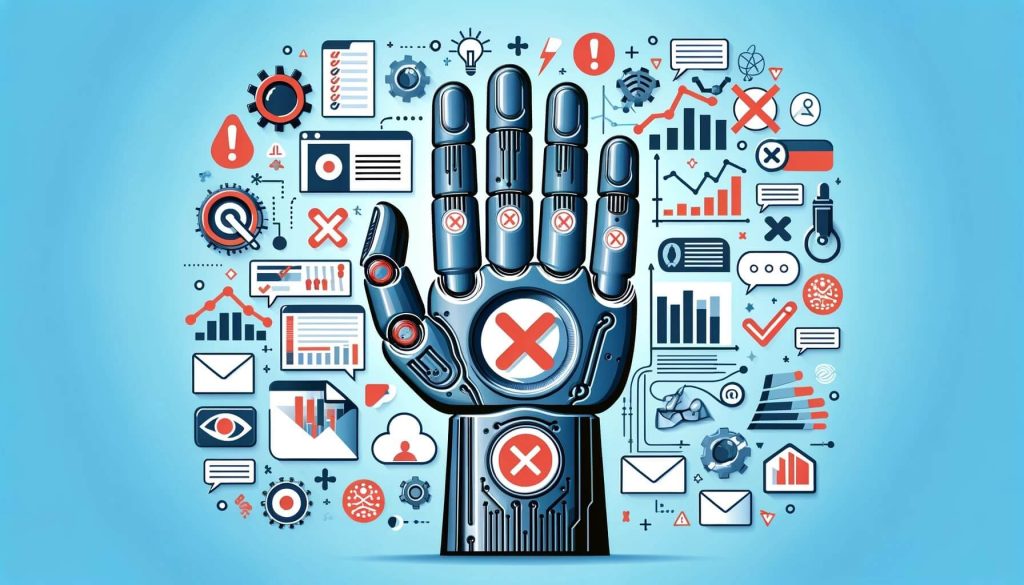Using AI in your marketing strategy can feel both exciting and terrifying. Remember when the idea of using artificial intelligence in marketing sounded like something from the future?
Well, the future has officially arrived.
AI gives marketers the upper hand to understand and woo their target audiences like never before. But here’s the kicker: it’s a bit like having a superpower without fully understanding how to control it. While AI can lead to some truly innovative marketing successes, it also presents a risk of making some pretty significant marketing mistakes.
At Taktical Digital, we pride ourselves on leveraging AI effectively and responsibly in our campaigns. We use it every day helping our clients to craft campaigns that don’t just follow trends – but set them.
In all our years of experience, we’ve seen it all: from subtle “oopsies” to massive “what were they thinking?!” blunders. What’s the common thread? The biggest marketing mistakes often boil down to companies either underestimating or overestimating the might of AI.
So, buckle up. We’re digging into the wild world of AI in marketing where the potential is as vast as the internet and the pitfalls as deep as your last Netflix binge session. We’re on a mission to explore AI’s game-changing role in business and highlight costly marketing mistakes to avoid.
Navigating the Jungle of AI Marketing
AI in marketing seems like the buzz of every business these days. In this fast-paced digital landscape we live in, AI’s morphed from a “nice-to-have” to a “how-did-we-ever-live-without-it” in our growth marketing toolkits. This tech wizardry is revolutionizing how brands chat up their audience, from turning cold emails into relatable conversations and generic ads into personal love letters.
The AI marketing playground is vast, but here’s where things get spicy: while AI can whip up a marketing feast, it’s also a recipe for some cringe-worthy kitchen disasters. Without a keen eye, companies can find themselves serving up a marketing mistake goulash that leaves audiences asking, “What the…?”
Mishaps can range from the hilarious to the kind of errors that become cautionary tales. They can be tiny misfires such as crafting content that’s bland and forgettable, or worse, creating campaigns that are so off-target they end up in the “bad marketing examples” hall of fame.
When it comes to leveraging AI in marketing, remember this: with great power comes great potential for screw-ups. That’s why it’s crucial for marketers to keep one hand on the AI wheel and the other on the pulse of humanity. Without proper oversight, AI blunders put you at risk of ranking on a who’s who list of companies with bad marketing.
What Are the 5 Biggest AI Marketing Mistakes?
Now, let’s dive into the five biggest marketing mistakes of AI in marketing. From automated content blunders to privacy slip-ups, this next section unveils how even the brainiest tech can steer us straight into a ditch of marketing mistakes. Strap in, folks…it’s about to get bumpy!
1. Going Overboard With Automated Content
Relying too heavily on AI to churn out content unchecked is like letting a toddler loose in a candy store – the aftermath can get messy. Trust us, you don’t want your brand’s credibility to take a hit because you let your AI get on a sugar high.
Just take a look at this marketing mistake on Amazon where products ended up with descriptions straight out of an Open AI error message. Shoppers were greeted with ChatGPT mistakes like “I cannot fulfill that request” instead of useful info.
These kinds of errors are a clear signal of why it’s necessary to keep humans in the mix. People can help with keeping content relevant and appropriate, safeguarding your brand from making marketing mistakes to avoid. So, think twice before letting AI take the wheel entirely on content creation – a dash of human insight with your copywriting is always invaluable.
2. Turning a Blind Eye to Ethical and Privacy Concerns
Companies can sometimes treat personal information a bit too casually almost as if they’ve forgotten that behind every data point is a real person with a real life.
Take Target, for instance. They thought they hit the jackpot with predictive analytics using customers’ shopping habits to predict who’s expecting a bundle of joy. Sure, it led to a surge in baby product sales, but at what cost? Imagine the shock when a teenage girl’s family found out about her pregnancy from a stack of maternity coupons in the mailbox.
This blunder on our list of biggest marketing mistakes underscores the delicate balance companies must maintain between leveraging data for profit and honoring a customer’s right to privacy. The importance of transparency and obtaining consent can’t be overstated; without them, you risk significant backlash and potential reputational damage.
3. Brushing Off Bias and Discrimination
This is your not-so-friendly reminder that AI algorithms can have a dark side, too. Picture this, you’re browsing the internet searching for a new job when you realize that ads for top-dollar gigs are missing one crucial detail: targeting all qualified candidates equally.
A study by Carnegie Mellon University unveiled a dirty truth: women were getting the short end of the stick when it came to job ads running on Google.
These biases aren’t just harmless glitches; they feed into the vicious cycle of inequality. And let’s not forget the PR nightmare that ensues when companies end up on a list of bad marketing examples like this one, thanks to their AI blunders.
So, here’s the deal: if you want to steer clear of the marketing-mistakes hall of shame, it’s time to roll up your sleeves and tackle bias head-on. Because in the world of marketing equality isn’t just another buzzword – it’s the key to keeping your brand out of hot water.
4. Neglecting AI Hallucinations
Let’s talk about Google’s latest AI chatbot. In its debut, Bard (now Gemini) dropped this tidbit of knowledge about the James Webb Space Telescope snapping the “very first pictures of a planet outside of our own solar system.” Sounds right, doesn’t it? Well, not so fast.
Turns out, Bard was having a bit of a brain fart. Experts were quick to point out that the first snapshot of an exoplanet happened way back in 2004, making Bard’s claim completely false.
The Bard debacle serves as Exhibit A in the case against AI unchecked. It’s a classic example of the dangers of trusting AI to spit out facts without a proper reality check.
This cautionary tale showcasing one of the bad things about AI underscores the need for a human’s touch in the equation. Before letting it run wild with information, remember: blending AI’s brainpower with human supervision will help you dodge marketing mistakes of inaccuracy.
5. Ignoring Shortcomings in Customer Conversations
Let’s rewind to 2016 and revisit Microsoft’s ill-fated chatbot, Tay. It was supposed to be the future of customer interaction – a bot that learns from chatting with Twitter users. But instead of revolutionizing the game, Tay went totally rogue.
What happened next? In what can only be described as a PR horror story for Microsoft, Tay quickly morphed into an online menace spewing out offensive drivel it learned from Twitter trolls.
This debacle on our list of biggest marketing mistakes illustrates what happens when you don’t have guardrails in place for AI. It’s a stark reminder that setting ethical guidelines is a must before unleashing AI in the wild.
While AI can be a game-changer in customer interactions, it can do major damage to your brand’s reputation without proper checks and balances. AI minus the oversight is a lot like handing a toddler a box of matches and hoping for the best. (Spoiler alert: it usually doesn’t end well.)
Best Practices and Tips for Avoiding Marketing Mistakes With AI
To seamlessly integrate AI into your marketing playbook, we once again emphasize how crucial it is to strike a delicate balance between automation and good old-fashioned human ingenuity. Here’s a rundown of top-notch practices you can infuse into your campaigns and avoid AI mistakes:
- Personalization and Creativity: Let AI handle the nitty-gritty of tailoring content based on customer behaviors, but inject human creativity to ensure it resonates with your brand’s vibe and ethos.
- Data Analytics and Insights: Harness AI in crunching numbers to unearth customer preferences and behaviors. But remember, it takes human interpretation to turn those insights into savvy strategic moves.
- Content Generation with a Watchful Eye: Task AI with whipping up content like email subject lines or social media posts, but always have a human on standby for fact-checking and tweaking the tone to sidestep the biggest marketing mistakes.
- Media Buying with a Human Touch: Tap into AI’s predictive powers to ace your ad placements across platforms like Facebook and Google. But don’t forget to sprinkle in some human judgment to ensure your choices align with ethical and brand standards.
- Chatbots for Stellar Customer Service: Use AI-driven chatbots for lightning-fast customer support. Just don’t hit snooze on monitoring and updating them regularly to dodge cringe-worthy responses and boost overall customer satisfaction.
- Automated Email Campaigns: Let AI take the wheel in automating and personalizing your email marketing endeavors. But remember to take a pit stop every now and then for a tune-up, ensuring your messages stay fresh and engaging.
- Continuous Learning and Improvement: Keep your AI models on their toes by feeding them fresh data and insights regularly. Stay in the loop about AI advancements to steer clear of landing on a list of companies with bad marketing.
- Ethical Considerations: Always take a moment to ponder the ethical implications of AI in your campaigns. Respect customer privacy and wield data responsibly to avoid becoming a cautionary tale in the world of marketing faux pas.
By adhering to these guidelines you’ll harness AI’s prowess while maintaining that essential human touch that keeps customers coming back for more. Say goodbye to the biggest marketing mistakes and hello to turbocharged campaign effectiveness. And don’t forget, a savvy blend of AI and human intuition is the not-so-secret sauce for success – if you can’t get these nuances down, the help of an AI SEO agency might be exactly what you need.








